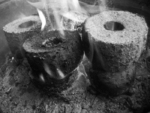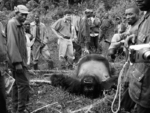Bio-Fuel Sells
by Chris Bolte
 When he heard that an entire family of gorillas had been murdered over charcoal in the Virunga National Park in the Democratic Republic of Congo, Robert Williams, of Nederland, Colo., stepped up efforts to expand production of a little-known alternative fuel.
When he heard that an entire family of gorillas had been murdered over charcoal in the Virunga National Park in the Democratic Republic of Congo, Robert Williams, of Nederland, Colo., stepped up efforts to expand production of a little-known alternative fuel.
The gorillas were slaughtered in 2007 by a group of African rebels who support themselves on charcoal production. But this charcoal isn’t pulled from the ground. Instead, it’s made from trees. According to Paulin Ngobobo, a Virunga park ranger who describes the process on the gorilla.cd webpage, first, a tree is cut down, the trunk not always being used, then the branches are stripped and stacked into a dome shape that is covered in mud. This mud separates the wood from the atmosphere, which causes the wood to burn stronger, making the charcoal. “It’s important to note that it takes 6 kilograms of fuel wood to make a single kilogram of charcoal,” Williams said, “It’s a terribly inefficient process.”
Killing the gorillas was a message intended for conservation-ists who wanted to protect the park and the gorillas. With only 700 mountain gorillas remaining, the killing of 10 represented a loss of one percent of their worldwide population.
 For Williams, it was a call to action. “Right now, [the Virunga National Park in the Democratic Republic of Congo] will be deforested in a decade,” he said. No trees means no habitat for the endangered gorillas. “If we undercut the demand for charcoal, then we undercut the rebel’s purpose for being in the Virunga National Park,” Williams stated.
For Williams, it was a call to action. “Right now, [the Virunga National Park in the Democratic Republic of Congo] will be deforested in a decade,” he said. No trees means no habitat for the endangered gorillas. “If we undercut the demand for charcoal, then we undercut the rebel’s purpose for being in the Virunga National Park,” Williams stated.
One solution to Virunga’s problem is a doughnut shaped fuel briquette made of non-woody agro-waste. It’s a product that has been marketed in third world countries for years by the Legacy Foundation, a non-profit organization working on issues of sustainability through technology. According to the Legacy Foundation’s Theory and Applications Manual, these briquettes can be made from “resources that are right under your feet or in your waste basket!”
The science is relatively simple; by taking leaves, grass and other materials leached of nutrients, then mashing them down to thumbnail size—letting them partially decompose to a point where there are visible fibers—they can be pressed, dried and used as fuel for cooking fires and heating. No trees need to be cut down and the material used will be constantly replenished.
Richard Stanley, founder of Legacy Foundation, is no stranger to world politics and desperate plights such as what Williams is taking on. “In Uganda, we worked with child soldiers. We tried to teach them a new trade so that they could get on with their lives,” Stanley stated. The Lord’s Resistance Army kidnapped children and forced them to fight and kill against their will. “Some of these kids had to kill their own parents,” Stanley said. As these kids became more visible in the briquette training sessions, the Lord’s Resistance Army became aware of their presence and tried to re-kidnap them. The program was shut down.
Benjamin Martin, who accompanied Stanley to Uganda in 2001, stated: “Some of those kids, despite everything they had been through, had better attitudes than people I know here in the states.”
Briquette training programs have been established in Malawi, Kenya, Peru, Mali, Zimbabwe, Mexico and here in the U.S. The American version will meet the demands of our ‘plug and play’ mentality, a fully automated machine about the size of a washing machine that takes the raw ingredients—including junk mail—and produces a briquette. A workable version has yet to be invented, though there are designs in the works.
Stanley said briquette makers might even have an impact in Haiti: “The mayor was bringing briquette makers together before the earthquake in order to address alternative fuels for their charcoal shortage.” Stanley noted that as money from donations begins to diminish there will remain a shortage of charcoal and that the established briquette makers already operating there may be able to fill that need.
Stanley has no delusions about his work. Sometimes firewood and charcoal are cheaper than briquettes, sometimes the people do not want to master the labor intensive methods necessary for briquette production and sometimes the larger political scene will not allow alternative fuels to hinder the massive profits of deforestation. “We have a 60 to 70 percent success rate, overall.” Stanley said.
Williams is all too aware of the challenges. He is facing his own problems in getting a briquette program off the ground. In Goma, a market place near the Virunga National Park where established teams are trying to sell the briquettes, some of the buyers are upscale and have more disposable income and often decline purchasing briquettes because of their smoke factor. If a briquette is dried properly, it will not smoke and will burn consistently. However, the Congo has two rainy seasons, causing the briquettes to not dry as much as they should and making them burn inconsistently. One solution to this problem is a briquette fired drying room, but this could cause them to dry too much and produce heavy smoke and burn up rapidly.
On the other hand, despite these issues of quality there is a demand for the briquettes by the Internally Displaced People (IDPs) who spend 40 percent of their income on charcoal and other fuel needs.
According to Williams, it costs $25-30 for 50 kilograms of charcoal, and the average person consumes 240 grams of charcoal per day in a family cooking situation, or roughly 11 cents per day. On the other hand, he says briquettes cost “$8 for 40 kilograms [and] the average person consumes three briquettes per day in a family cooking situation.” There are roughly 350 briquettes in a 40 kilogram sack, so the average family using briquettes for fuel spends roughly 7 cents per day.
The situation for Virunga National Park has reached a critical point because all the forests outside the park have been cut down leaving the rebels with only what is inside. “The rebels are heavily armed and the park rangers put their lives on the line every day.” Williams said.
With the press and briquette program in full bloom, Williams says that the main concern at this point is funding for the park itself. There is a program on the www.gorilla.cd website under the ‘protect the park’ option where donors can adopt an acre of the park for $25 a month. The funds go to the hiring of more guards who patrol the park for rebels and the removal of wildlife snares that gorillas get caught in.
“There will always be people willing to walk along side a volcano and do very dangerous work to get charcoal, but if we have enough funds to protect the park, hire armed guards and keep as many rebels out as possible, charcoal use will decline and eventually briquettes will be used more frequently.” Williams stated.•
